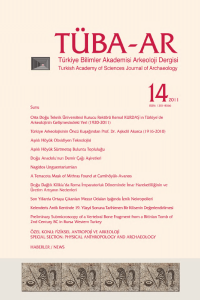Abstract
İskelet kalıntılarından, sıklıkla yeme alışkanlığının tarihçesini ve yaşam biçimini, demografilerden ise fiziki, genetik ve sağlıkla ilgili özellikleri belirlemek amacıyla yararlanılır. Bu çalışmanın amacı, İstanbul'da Marmara Denizi kıyısında yaşamış Geç Bizans topluluğunun fiziki karakterlerini araştırarak bõlgedeki beslenme ve sürekli şehirleşmenin etkisini ortaya koymaktır. Çalışılan kalıntılar, Küçük Ayasofya Camii'nin 1,5 maltında bulunan beş mezardan elde edilmiştir. Ölüm yaşı, cinsiyet, diş ve topluma özgü spesifik hastalıklar araştırılmıştır. Topluluk, 5 çocuk, 9 yetişkin ve 6 yaşı bilinmeyen kişiden oluşmaktadır. Grupta, az sayıda periostitis, spondylolithesis, spina bifida ve nadir görülen olan pembe diş vakası saptanmıştır. Bir yetişkin erkekte ekstrem diz eklemi ve bazı yetişkinlerde de vertabrada osteofit gelişimi gözlenmiştir. Diş, travma ve enfeksiyonel hastalıklardan belirlenen topluluğun sağlığının hem uzun süren şehirleşme hem de ağır fiziki güç gerektiren işçiliklerde çalışılmasından ötürü beslenme sorunu yaşadığı ve travma geçirdiği düşünülmektedir.
Keywords
References
- Angel, J. L., 1971. "Early Neolithic Skeletons from Çatalhöyük, Demography and Pathology", Anatolian Studies 21: 77-97.
Abstract
Skeletal remains are the conventional materials used in assessing the physical, genetic, and health characteristics of past cultures and to infer on their dietary history, lifestyle and demography. The purpose of this study is to examine the characteristic markers in the life of a Late Byzantine population who lived near by the Sea of Marmara in Istanbul and to assess the nutrition and effects of urbanization in the area. Remains are from the five graves uncovered 1,5 m under the floor of the Küçük Ayasofya Mosque. In the study, age at death, sex, dental and skeleton population specific diseases were examined. The population consists of 20 individuals; 5 subadults, 9 adults and 6 unaged. There were a few cases of disease including periostitis, spondylolisthesis, spina bifida and a rare case of pink teeth of P2. There was a well developed arthritis in a male knee joint and vertebral osteophytes in some adults. The health is determined from teeth, trauma and infectious diseases of the skeletal remains. It is thought that there were various factors related to increased urbanization and intense labor causing nutritional stress and trauma.
Keywords
References
- Angel, J. L., 1971. "Early Neolithic Skeletons from Çatalhöyük, Demography and Pathology", Anatolian Studies 21: 77-97.
Details
| Primary Language | English |
|---|---|
| Subjects | Archaeological Science, Urban Archeology, Medieval Age Archeology, Archeology of Turks, Habitat Archeology |
| Journal Section | Research Articles |
| Authors | |
| Publication Date | August 10, 2011 |
| Submission Date | February 19, 2011 |
| Published in Issue | Year 2011 Issue: 14 |
Cite
Publisher
Vedat Dalokay Caddesi No: 112 Çankaya 06670 ANKARA
The contents of this system and all articles published in Journal of TÜBA-AR are licenced under the "Creative Commons Attribution-NonCommercial-NoDerivatives 4.0".


